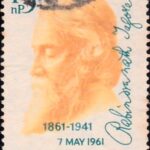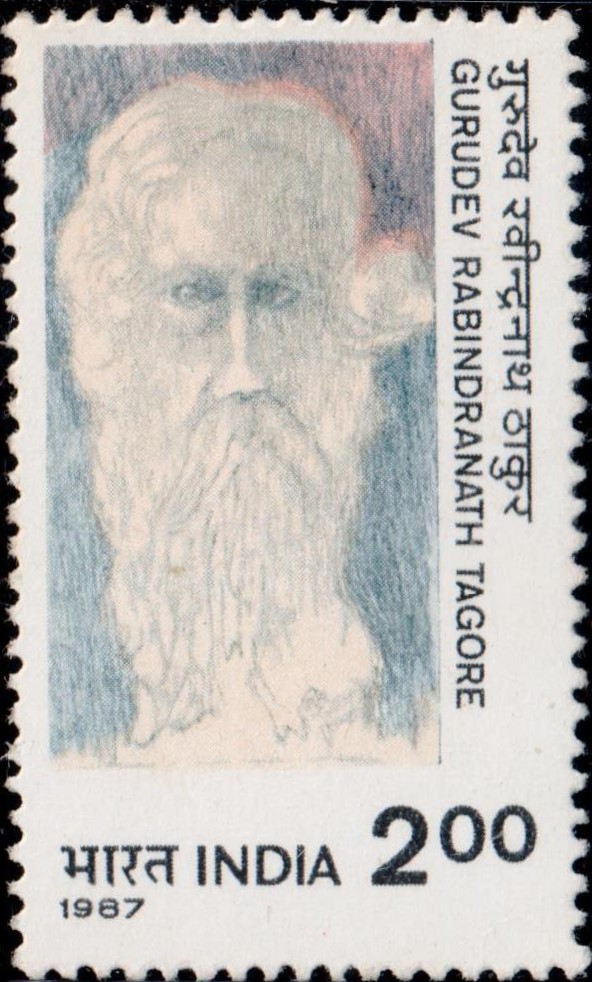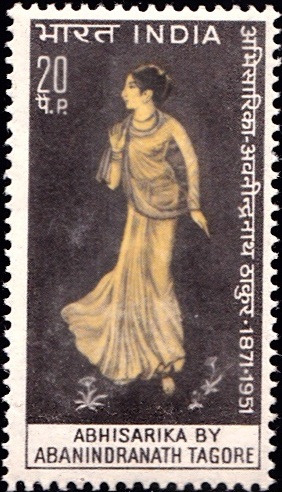
Gaganendranath Tagore
A commemorative postage stamp on Gaganendranath Thakur, an Indian painter and cartoonist of Bengal School of Art, brother of Abanindranath Tagore and nephew of Rabindranath Tagore :
 Issued by India
Issued by India
Issued on Sep 17, 1968
Issued for : The Indian Posts and Telegraphs Department is happy to honour Gaganendranath‘s great name by issuing a commemorative stamp with his self-portrait, on the eve of the 101st anniversary of his birth.
Design : The design of the stamp is vertical and depicts a self portrait of Gaganendranath Tagore. The words Bharat INDIA are shown at the top left hand corner. The year of birth and death viz. 1867-1938 and value 20 paisa, appear at the bottom left and right corners respectively. The name Gaganendranath Thakur (Gaganendranath Tagore) appears below the portrait and outside the design.
Type : Stamp, Mint Condition
Colour : Buff and Red Purple
Denomination : 20 Paisa
Overall Size : 3.91 X 2.90 cms
Printing Size : 3.56 X 2.54 cms
Perforation : 13 x 13
Number per issue Sheet : 35
Printing Process : Photogravure
Printers : India Security Press
Name : Gaganendranath Thakur
Born on Sep 18, 1867 at Jora Sanko, Kolkata, West Bengal, India
Died on Feb 14, 1938 at Kolkata, West Bengal, India
About :
- The members of the great Tagore family of Bengal were among the pioneers of the Indian Renaissance at the turn of this century. Abanindranath and Gaganendranath, nephews of the great Poet Tagore, gave expression to the new awakening in the field of painting. Gaganendranath was the lesser-known of the two but his work was by no means second-rate.
- Born on September 18, 1867, Gaganendranath took to painting rather late in life. He did not follow the set patterns of the new Bengal School. He broke new ground and took some of his ideas from the Cubist and Futurist schools then in vogue in Europe. But these alien influences did not sweep him off his feet. He remained an Indian painter, first and last. Although his productions owed much to foreign trends there was nothing hybrid about them as they were rooted in true Indian traditions. All through them runs the transforming mark of his originality. “The homely simplicity of his Chaitanya series of paintings, the beauty and breadth of his landscapes, the effortless suggestiveness of his portraits” – these are the distinctive paintings of a great artist.
- Gaganendranath has been called a painter of the modern city. In this, too, his contribution has been unique because most of our artists do not feel quite at home in themes with an urban background. When he paints the evening sky, one recognizes the Calcutta sky, with its smoke and dust. The two women leaning on the parapet wall are confident and self-conscious, not coy and retiring village brides. His Durga Puja Immersion Procession is a spirited representation of a real city street.
- Gaganendranath carved out a niche for himself in another field usually avoided by great painters, that of the cartoonist. The most important of his cartoons date from 1915 to 1922. These were highly expressive and reflected “all the irreverence and irony of the revolutionary“. Cartoons like the “the Scream” series and “Peace restored in the Punjab” (on the Jalianwala Bagh tragedy) were distinguished by the artist’s unfailing courage and directness and left a telling impression on the contemporary viewer.
- Gaganendranath was stricken with facial paralysis about the year 1930, and passed away in 1938. But his memory lives on in his paintings and sketches. Fifty years after his great works began to appear, he still regarded as the most authentic experimentalist of our times. In fact, his talent is being increasingly appreciated with the passing years, a sure indication that his was not the flowering of a transient genius. Artists in India have been celebrating the centenary year of this departed master.







